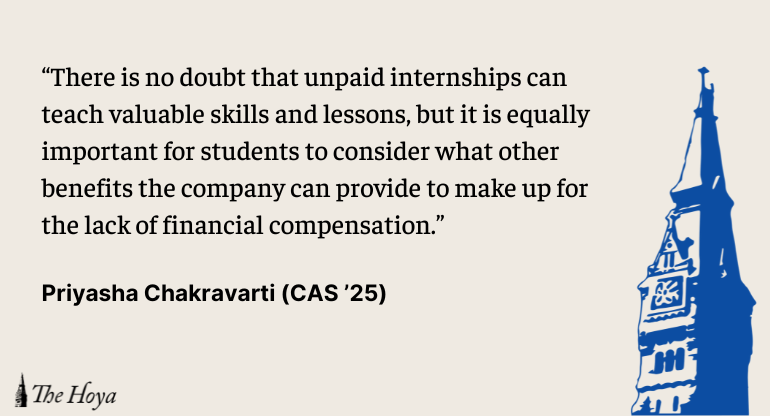The start of the school year usually comes with a flurry of new academic endeavors, extracurricular opportunities and social experiences. But it may also come with the looming stress of internship applications, especially for sophomores and juniors. Students quickly begin to lose balance, juggling cover letter drafts, making last-minute resume edits and scheduling networking calls and coffee chats. They try their best to calmly navigate the pre-professional culture that seems to have permeated to the core of many colleges today.
Pre-professional culture and pressure can be very demanding for some students, depending on the college they attend, their life circumstances, their priorities and their desired industry of employment. At Georgetown University, students often take on internships during both the academic year and the summer, especially given the number of opportunities available in Washington, D.C.
Internships are a common and perhaps crucial part of university life, especially for students looking to gain professional and employable skills. However, the age-old debate over the worth of unpaid internships continues to rage.
I have taken on unpaid internships both in the United States and in India, my home country. Although I acquired valuable insight and learned new skills both times, I was troubled by the fact that such positions disadvantage students with financial needs. Companies and organizations should slowly phase out unpaid internships, or at the very least, consider offering alternative benefits to students in exchange for their time.
For low-income and first-generation students, however, it can be difficult to commit to unpaid internships. As a result, these positions inevitably cater to a more financially wealthy student body, who are able to dedicate their time and work outside of class without necessarily needing the money to pay their expenses. This inability to afford unpaid positions can deepen inequalities based on income, social status, background and even race.
In an effort to combat this, in July 2021, President Joe Biden issued an executive order to advance diversity and inclusion in the federal government. It included measures to “reduce the Federal government’s reliance on unpaid internships,” specifically because they create barriers of entry for low-income and first-generation students.
Yet, a recent National Association of Colleges and Employers (NACE) study found that 40% of the interns surveyed were not paid for their most recent work, indicating that unpaid internships are still prevalent. This lack of compensation can be attributed to a variety of reasons on the organization’s end. For example, nonprofit organizations and smaller startups may not have the bandwidth to pay all their interns.
Another study conducted by NACE in 2019 found that out of the 4,000 seniors surveyed across 470 colleges, Hispanic and Latinx students were the least likely to have had an internship by graduation. In addition, Black students make up the largest percentage of unpaid interns. The fact that these historically marginalized communities are primarily affected by the plight of unpaid internships is extremely worrying, disappointing and counterproductive.
Although unpaid internships are not conducive to everyone, they can still be a valuable experience for those who can commit to one despite the financial burden. I am grateful to be in the financial position to take on unpaid internships solely for experience and growth. However, the positions I pursued did offer benefits as a substitute for money.
In spring 2023, I interned remotely for the National Peace Corps Association, located right here in D.C. The organization had an academic credit requirement, so I was able to take a Georgetown internship class that counted toward my degree simultaneously.
This past summer, in my home country of India, I served as a philanthropy and fundraising intern at the S M Sehgal Foundation, India’s top rural development nongovernmental organization. Although the position was unpaid, the organization offered living accommodations, free lunches, direct mentorship and guided field/project site visits for all interns.
I had very fruitful and positive experiences with both internships and was appreciative of the benefits. The model employed by both of these organizations is something that more companies should employ in the future, especially if they are unable to pay their interns hourly.
There is no doubt that unpaid internships can teach valuable skills and lessons, but it is equally important for students to consider what other benefits the company can provide to make up for the lack of financial compensation. More importantly, race and income-based inequities should not be exacerbated by creating additional financial barriers for students.
The Georgetown administration, specifically the Cawley Career Education Center, can support students by approving and promoting positions that either pay hourly or offer the kinds of benefits listed above. The unpaid internship system still has room to grow, but must continue to evolve to be accessible to students regardless of race, income levels and background.
Priyasha Chakravarti is a junior in the College of Arts & Sciences.














